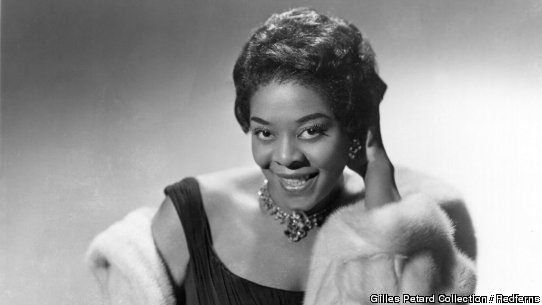I knew of Dinah Washington’s multiple marriages well before I fell for her voice. I was ten when she married her 7th husband, Dick “Night Train” Lane, the All-Pro defensive back of the Detroit Lions. The Lions were then, as now, a staple of Thanksgiving television and a most welcome diversion from the press of people crowding my grandmother’s house. Lane was a fearsome cornerback whose penchant for tackling opponents around the head came to be known as a “Night Train Necktie.” Contrary to popular belief, however, he earned his colorful nickname not from Jimmy Forrest’s r&b classic, “Night Train,” which was a hit during Lane’s record-setting rookie season with the Los Angeles Rams in 1952, but because he took trains at night rather than risk flying to games in other cities. This I learned later; what stuck in my mind as a young Catholic kid was the news that Lane’s wife had been married six previous times.
Quincy Jones never tied the knot with Miss D, but they tied one on early in Q’s tenure as her arranger. Around the time he was preparing charts for Dinah’s 1955 EmArcy album, For Those in Love, Miss D asked the 22-year-old, “Is your wife married?” then seduced him over a tray of cocktails. Jones told Washington’s biographer, Nadine Cohodas, “She used to call me ‘grasshopper kid’ because I was young and green, and we used to drink grasshoppers together.” After the first night of what he called their “tryst,” Dinah rang up Quincy’s home to recount what had gone down between them a few hours earlier, only it was Q’s wife Jeri who answered the phone. Call it an instance of life imitating art: A decade earlier, on one of her earliest hits, “Blow Top Blues,” she sang,
“I got high last night, and took my man to his wife’s front door/
“I got so juiced, I took my man to his wife’s front door/
“But she was a 45-packin’ mama, and I ain’t gonna do that no more.”
Quincy devised the jazziest arrangements Dinah ever sang on For Those in Love and her follow-up release, The Swingin’ Miss D. Throughout the fifties, her working trio included the jazz greats Wynton Kelly, Keter Betts, and Jimmy Cobb, and her albums featured soloists including Clifford Brown and Cannonball Adderley. (Cobb is the only surviving member of the Miles Davis Sextet that recorded Kind of Blue, the biggest selling album in jazz history.) For Those in Love, an album of ten redoubtable standards, featured Kelly and Cobb as well as trumpeter Clark Terry, saxophonist Paul Quinichette, and guitarist Barry Galbraith.
Jones understood that Dinah’s blues and gospel-infused approach could breathe a different kind of life into Tin Pan Alley tunes by Cole Porter, Leo Robin, Dorothy Fields, and Rodgers & Hart. In Listen Up: The Lives of Quincy Jones, he said, “Dinah could really apply a blues interpretation to a pop song; she just knew how to bend all the notes and take it away from the melody just enough so that she put her trademark on it. Nobody could sing a version like that but her.”

Dinah’s bold timbre, precise diction, and note-bending style were instrumental in opening up pop music to the influence of gospel, and furthering the pervasiveness of blues tonality in modern music. The Alabama-born, Chicago-raised singer came under the influence of Sallie Martin, a founder of the Gospel Singers Convention, when she was in her mid-teens. The gospel world frowned on singers transgressing the boundaries of the church to sing blues and pop, but Dinah defied convention and joined Lionel Hampton in 1943, the same year in which she made her recording debut as a 19-year-old singing “Evil Gal Blues.” As she rose to fame as the biggest-selling black female artist of the fifties, she paved the way for singers like Little Esther Philips, Ray Charles and the gospel star Sam Cooke to follow suit. By the time her most famous disciple, Aretha Franklin, emerged in the early sixties as a singer at home in both nightclubs and her father’s church in Detroit, the sacred vs. secular controversy was giving way to a tidal wave of commercial success. The increasingly mainstream popularity of r&b (Motown) and soul music (Stax) in the sixties left little doubt that the music’s roots, and the singers who laid it on the line, came out of the church.
Miss D’s influence resounds down to the present. In this 2006 BBC documentary, Amy Winehouse extols her as both a no-nonsense singer of jazz, pop, and blues, and a prototype for what Winehouse viewed as uncompromising defiance.
Here’s a series of clips of Miss D in action, beginning with “Lover Come Back to Me,” the standard she’d recorded with Brownie in 1954.
From the same show, Dinah sings “Send Me to the ‘Lectric Chair,” the classic blues she’d recorded on her Bessie Smith tribute in 1958.
Here she is introduced by Ronald Reagan and accompanied by Louis Jordan on a 1960 television appearance. The illusion is that they’re at the Apollo, scene of countless appearances by the Queen of the Blues, but they’re actually on a soundstage in Hollywood. Dinah sings her hits “What a Difference a Day Made” and “Makin’ Whoopee.”
